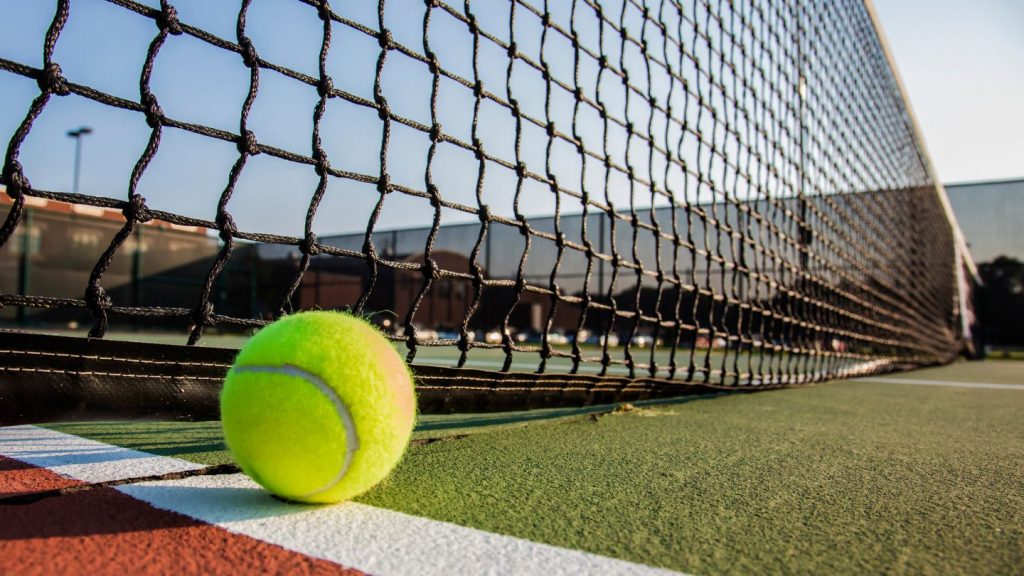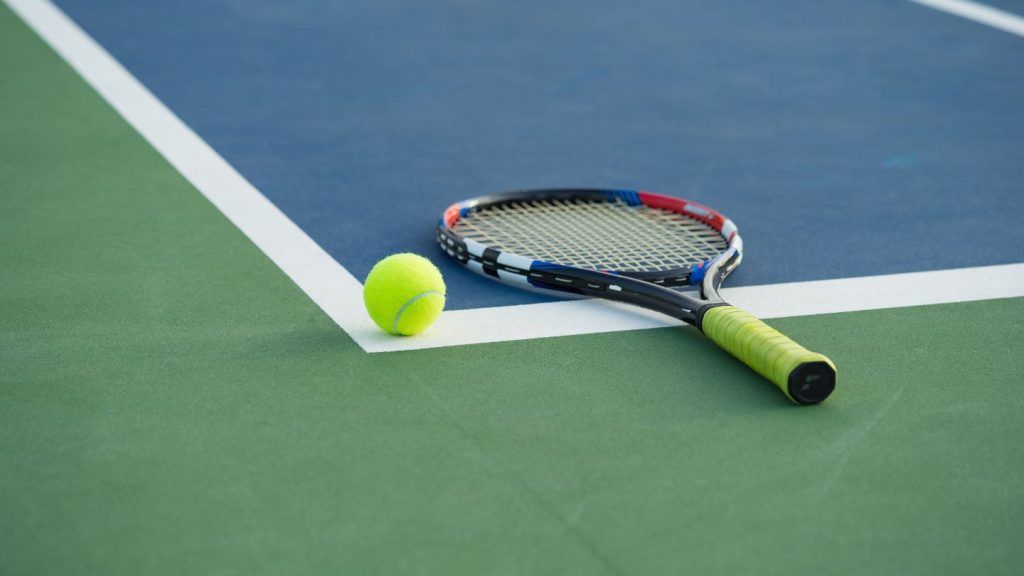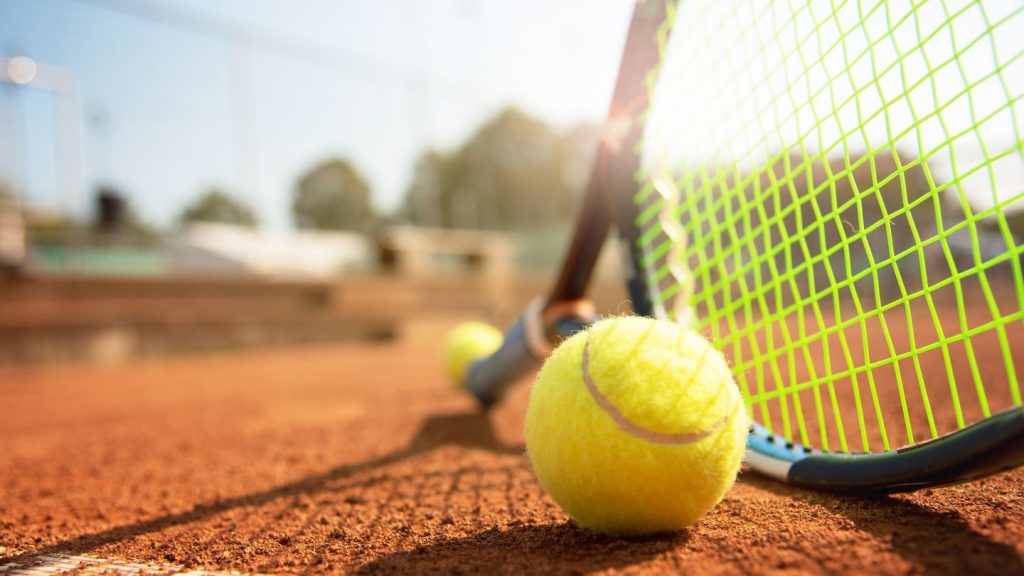Maintaining and resurfacing a tennis court is vital for its longevity and playability. In this ultimate blog on tennis court maintenance and resurfacing, we’ll cover everything you need to know: understanding different surfaces, regular maintenance routines, dealing with everyday issues, and the resurfacing process.
Key Takeaways
- Different types of tennis court surfaces (clay, grass, hard courts, synthetic grass) require distinct maintenance practices to ensure playability and longevity.
- A structured maintenance routine involving daily cleaning, weekly inspections, and monthly deep cleaning is essential for preventing costly repairs and ensuring court safety.
- Timely resurfacing, informed by visible signs of wear and tear, is crucial for maintaining a tennis court’s quality, and a proper contractor selection is necessary for successful resurfacing projects.
Understanding Different Tennis Court Surfaces
Tennis courts vary greatly from one another. The surface material plays a significant role in how the game is played, the maintenance required, and the overall experience for players. There are four main types of tennis court surfaces:
- Clay
- Grass
- Hard courts
- Synthetic grass
Each has its own characteristics and maintenance needs that affect playability and longevity.
Clay courts, known for their slower pace and higher bounce, require consistent rolling, watering, and sweeping to maintain their playability on clay surfaces. This meticulous care helps keep the surface smooth and prevents the buildup of debris.
Grass courts, the fastest of all surfaces, demand intensive upkeep, including regular mowing and watering. The natural surface of grass courts can be quite susceptible to wear and tear, requiring almost daily attention to maintain optimal conditions on the court’s surface.
On the other hand, hard courts, made from materials like asphalt, acrylic, or concrete, offer a balance of speed and consistency, making them a popular choice for various playing styles. These courts generally require less frequent but still crucial maintenance, such as periodic resurfacing every 4 to 8 years to maintain their integrity.
Synthetic grass courts mimic the bounce of real grass while offering lower maintenance requirements. Regular debris removal and inspection for drainage issues are essential to keep these courts safe and playable. Knowledge of these court surfaces is fundamental for effective maintenance and resurfacing.
Regular Maintenance Routines for Tennis Courts

Consistent maintenance is the backbone of a well-maintained court. It ensures safety, prolongs the court’s lifespan, and delays costly resurfacing needs. Creating maintenance schedules with daily, weekly, and monthly tasks ensures the court remains in top playing condition.
Understanding the importance of tennis court maintenance highlights how regular cleaning, inspections, and timely repairs preserve court quality and extend its lifespan. Daily cleaning practices, weekly inspections, and monthly deep cleaning are all part of a comprehensive maintenance routine.
Daily Cleaning Practices
Daily cleaning prevents surface damage. It involves removing leaves and removing debris to prevent surface contaminants from accumulating and causing damage. Regular inspections for mold and debris help maintain the court’s surface integrity.
Using proper drainage techniques and a mild detergent solution can help keep the court clean and safe for play.
Weekly Maintenance Tasks
Weekly maintenance tasks are just as important. They involve inspecting the court for minor damages, ensuring proper drainage to prevent water pooling, and cleaning the surface to prevent deterioration.
Prompt attention to these issues can prevent major repairs and ensure the court’s performance and safety.
Monthly Deep Cleaning
Monthly deep cleaning is crucial for preventing mold and mildew buildup, which can compromise a court’s safety and playability. To maintain the court’s integrity, follow these steps and use the essential tools:
- Use a pressure washer with low PSI to remove grime and dirt from hard courts.
- Apply a mild detergent solution diluted as per manufacturer instructions.
- Utilize a blower to clear debris.
- Use a soft-bristle broom for effective cleaning.
Deep cleaning inspections can identify and seal minor cracks, keeping the court in optimal condition.
Dealing with Common Tennis Court Issues
Tennis courts frequently encounter issues such as cracks, stains, and surface contamination, which can affect playability and safety. Promptly addressing these problems can prevent major repairs and tennis court crack repair, especially when using non-marking tennis shoes.
Identifying the biggest tennis court problems early, such as cracks, drainage issues, and surface wear, helps owners take preventive action and avoid costly repairs.
Repairing cracks, removing stains, and tackling mold, mildew, and algae are essential aspects of maintaining a well-kept court. Effective strategies for killing moss on tennis courts include proper cleaning, drainage management, and specialized treatments to keep the surface safe and playable.
Repairing Cracks
Repairing cracks is important because:
- It prevents further damage and maintains the court’s surface.
- Prompt attention to minor cracks can prevent water from entering and causing more extensive damage.
- Using high-quality repair materials ensures that the repairs are effective and long-lasting.
Regular maintenance and inspections can identify cracks early, allowing for timely, cost-effective repairs.
Read More: Resurface vs. Repair Your Tennis Court: Which is the Better Option?
Removing Stains and Surface Contaminants
Stains and surface contaminants can be removed using specific cleaning solutions tailored to the nature of the stain. A mixture of four parts water and two parts trisodium phosphate is effective for cleaning visible stains.
Additionally, a combination of mild detergent, trisodium phosphate, and bleach can clean dingy tennis courts. Pressure washing or using a specialized court cleaning machine is recommended for deep cleaning acrylic tennis courts.
Tackling Mold, Mildew, and Algae
Humid or shaded areas promote mold, mildew, and algae growth on tennis courts. A household bleach and water mixture is effective in killing mold and mildew.
Applying the solution, scrubbing gently, and rinsing thoroughly helps keep these growths at bay, ensuring the court remains safe and playable.
Tennis Court Resurfacing: When and How

Resurfacing a tennis court is essential for maintaining its quality and protecting your investment. Common signs that indicate the need for resurfacing include visible cracks, faded colors, and significant wear and tear. Timely resurfacing helps maintain the quality of play and prevents escalating problems that can lead to costly repairs.
The resurfacing process includes cleaning the existing surface, addressing minor repairs, and applying a new surface layer to restore playability. Accurately calculating the cost to resurface a tennis court requires assessing surface type, repair needs, and material choices to budget effectively and maintain top playing conditions.
Identifying Signs of Wear and Tear
Early identification of surface wear is essential for timely resurfacing. Common warning signs include early signs of visible cracks, faded paint, and uneven textures. Regular inspections can catch these signs early, preventing them from escalating into more significant issues.
Signs that a court needs resurfacing include faded paint, worn-out areas, loss of traction, and water pooling, as well as repainting lines, especially due to freeze-thaw cycles.
Read More: How Often Should I Inspect My Tennis Court?
The Resurfacing Process Explained
The resurfacing process involves several steps to ensure a smooth and durable court surface. First, pressure wash the court to remove dirt and debris. Next, repair any surface imperfections using specialized materials to match the original surface’s elasticity.
Apply an acrylic resurfacer base coat, followed by 2 to 3 coats of color and texture to enhance playability and durability on acrylic surfaces and acrylic coatings. Allow the court to fully cure for 3 to 7 days before use.
Surface-Specific Resurfacing Guidelines

Different surfaces require specific resurfacing and maintenance approaches. Understanding the unique characteristics of each tennis court surface type is critical for effective resurfacing and ensuring a consistent playing surface.
An incorrect approach can cause more harm than good.
Hard Courts
Hard courts, made from materials such as asphalt, acrylic, or concrete, require resurfacing every 4 to 8 years to maintain optimal playing conditions. Structural issues may necessitate a full replacement to restore the court’s integrity.
Regular maintenance, such as cleaning and repairing minor cracks, preserves the court’s performance and safety through proper maintenance.
Clay Courts
Clay courts require frequent and specialized care to remain competitive. Professional resurfacing and maintenance are key to keeping clay courts in top condition. These courts typically require resurfacing every 1-2 years to maintain their quality.
Regular watering and sweeping are also necessary to keep the surface smooth.
Synthetic Grass Courts
Synthetic grass courts offer a lower-maintenance alternative to natural grass while providing a similar playing experience. Regular maintenance, such as removing debris and inspecting for drainage issues, is crucial for extending the court’s lifespan.
Resurfacing synthetic grass courts involves adding a new layer of turf when the fibers become frayed. Preventive measures like regular inspections and timely replacement of worn areas can greatly extend the lifespan of these courts.
Extending the Life of Your Tennis Court
Maintaining tennis courts extends their lifespan and ensures safety and performance for players. Regular maintenance helps reduce the occurrence of common issues like cracks and stains, enhancing both safety and playability.
Professional maintenance, such as pressure washing and crack filling, is crucial for prolonging the court’s life. Implementing a structured maintenance routine can minimize the risk of incurring expensive repairs over time.
Preventive Measures
Preventive measures help avoid extensive repairs. Addressing cracks promptly can save on costs associated with more extensive crack repairs in the future and help prevent situations that require costly repairs.
Clay courts need specialized care and regular maintenance to keep the playing surface in good condition. Avoiding harsh chemicals or de-icers on the court can prevent damage to the playing surface.
Read More: How to Maintain a Clay Tennis Court
Seasonal Maintenance Tips
Seasonal maintenance protects tennis courts from weather-related damage. Factors that increase the likelihood of mold and mildew growth include:
- Humidity
- Shaded areas
- Excess moisture
- Organic debris
These conditions require regular inspections and timely treatments to prevent damage.
Effectively managing these factors keeps the court in top shape year-round.
Customization and Upgrades During Resurfacing
Resurfacing offers opportunities for customization and upgrades, including:
- Upgrading or reconfiguring the court
- Integrating multi-use layouts
- Adding custom logos or branding to enhance aesthetic appeal and functionality
- Personalizing the court with bold color schemes
- Adding additional line markings for training or multi-sport configurations to increase versatility
Adding motivational quotes, school mottos, and upgraded fixtures personalizes and enhances the court’s uniqueness.
Costs and Budgeting for Tennis Court Maintenance and Resurfacing
Planning and budgeting for maintenance and resurfacing help avoid unexpected expenses and keep the court in optimal condition. The cost to resurface a tennis court typically ranges between $10,000 and $50,000, influenced by factors such as surface material, court size, and the extent of repairs needed. Resurfacing a hard court can cost between $4,000 and $10,000.
Larger courts require more materials and labor, impacting costs. Periodic resurfacing planning prevents large, unplanned expenses, making budgeting for these projects essential.
Choosing the Right Contractor for Resurfacing Projects
Selecting the right contractor for resurfacing projects is critical for achieving high-quality results. Key factors to consider include:
- Experience in tennis court construction
- Specific knowledge of surface materials and drainage
- Being licensed and insured to protect against potential liabilities
Effective project management, including providing detailed timelines and regular updates, is essential during the resurfacing process and the resurfacing project. Asking for references and assessing the quality of previous work can ensure reliability and satisfaction with the final outcome.
Comparing quotes and evaluating service levels can help in selecting a qualified contractor for resurfacing projects.
Read More: Questions to Ask a Tennis Court Contractor Before Hiring
Final Thoughts
Maintaining and resurfacing tennis courts is essential for safety, long-term durability, and consistent playability. By understanding different court surfaces and their unique maintenance needs, creating structured cleaning and inspection schedules, addressing cracks or stains promptly, and planning timely resurfacing, owners can extend the life of their courts and avoid costly repairs.
For professional solutions, Talbot Tennis provides trusted services for tennis court resurfacing in Georgia, along with expert construction, repair, and ongoing maintenance. With decades of industry experience, the company delivers precision workmanship and customized upgrades to ensure courts remain in top playing condition for years to come.
Frequently Asked Questions
How often should a tennis court be resurfaced?
A tennis court should be resurfaced every 4 to 8 years, taking into account the type of surface, frequency of use, and climate conditions. Regular maintenance ensures optimal playing conditions and extends the lifespan of the court.
Can tennis courts be pressure-washed?
Tennis courts should not be pressure-washed due to the risk of surface damage. Instead, utilize a pressure washer with low PSI or a specialized cleaning machine for safe and effective maintenance.
What are the common signs that a tennis court needs resurfacing?
A tennis court typically needs resurfacing when you observe visible cracks, faded paint, worn-out markings, uneven textures, loss of traction, or water pooling. Addressing these issues promptly will help maintain optimal playing conditions.
What factors influence the cost of resurfacing a tennis court?
The cost of resurfacing a tennis court is influenced by factors such as the surface material, court size, the extent of necessary repairs, premium finishes, and optional features like cushioned layers. Understanding these elements can help you estimate the overall investment required for the project.
